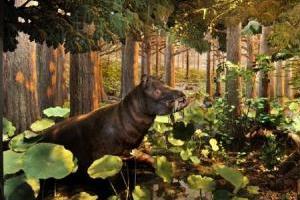 Isotopic studies of Eocene mammal teeth reveal a world of semi-darkness, where huge prehistoric mammals roamed a lush and swampy Arctic, writes Sarah Day.
Isotopic studies of Eocene mammal teeth reveal a world of semi-darkness, where huge prehistoric mammals roamed a lush and swampy Arctic, writes Sarah Day.
Geoscientist online, 5 June 2009
It’s difficult to imagine the Arctic as anything other than a world of ice and polar bears. During the Eocene epoch, however, alligators, aquatic turtles, giant tortoises, snakes and even flying lemurs all made their home there, in a landscape of lush, swampy forests.
They were joined by a wide variety of larger mammals, some as heavy as 1,000 pounds. A study led by Jaelyn Eberle, curator of fossil vertebrates at the University of Colerado Museum of Natural History, has revealed detailed information about the diet of some of these creatures, which in turn helps to deepen our understanding of the Arctic climate.
Eberle and her team analysed the carbon and oxygen isotopes extracted from the fossilised teeth of three mammals living on what is now Ellesmere Island near Greenland; a hippo-like, semi-aquatic creature called a Coryphodon, an ancestor of today’s tapirs, and a rhino-like creature called a brontothere. Teeth from the high Arctic are particularly valuable to palaeontologists, because they are hard enough to withstand the freeze-thaw conditions that happen every year.
Results from the carbon isotope analysis of tooth enamel, which forms in sequential layers during tooth eruption, provided information about what types of plants the mammals were eating through the seasons. This demonstrated that their diet was gleaned from the high Arctic all year round. ‘We were able to use carbon signatures preserved in the tooth enamel to show that these mammals did not migrate or hibernate’, said Eberle. ‘Instead, they lived in the high Arctic all year long, munching on some unusual things during the dark winter months’.
During the summer, the mammals appear to have lived on a diet of flowering plants, deciduous leaves and aquatic vegetation, whist during the dark months of winter they seem to have switched their diet to such delicacies as twigs, leaf litter, evergreen needles and fungi.
By analysing the oxygen isotopes from the teeth, the researchers were able to look in more detail at the nature of the drinking water available at the surface, providing information about precipitation and temperature which furthers our understanding of the climate at that time. The results suggests that summers were warm and humid, whilst winters were mild, with temperatures overall ranging from just above freezing to near 70 degrees Fahrenheit.
Today, Ellesmere Island enjoys temperatures ranging from minus 37 degrees F in winter to 48 degrees F in summer, making it the coldest, driest environment on Earth. Tree stumps from warmer days can still be seen, some as large as washing machines, but vegetation is now sparse, and the few mammals that survive are small.
The region is sunless between October and February, and enjoys constant sunlight from mid-April through to the end of August. Eberle believes that the large Eocene mammals’ ability to survive in the high Arctic all year round was a ‘behavioural prerequisite’ for their eventual migration across the land bridges which are thought to have then linked Asia and Europe with North America. The idea that they took part in long, seasonal migrations to escape the dark winter months is unlikely, she argues, because of information we have on their diet, size, and the fossil evidence for babies and juveniles in the Arctic.
‘In order for mammals to have covered the great distances across land bridges that once connected the continents, they would have required the ability to inhabit the High Arctic year-round in proximity to these land bridges’, Eberle suggests.
She believes it is more likely that the animals gradually moved south in small increments over millions of years, in response to shifting climates. Such behaviour may provide information about the future response by Arctic plants and animals to current global warming. With temperatures in the Arctic rising twice as fast as those in mid-latitudes, conditions are edging closer towards those of the Eocene epoch.
‘We are hypothesising that lower-latitude mammals will migrate north as the temperatures warm in the coming centuries and millennia’, says Eberle. ‘If temperatures ever warm enough in the future to rival the Eocene, there is the possibility of new intercontinental migrations by mammals’.